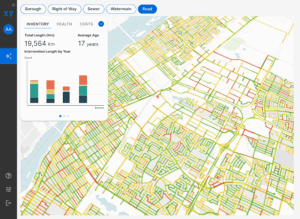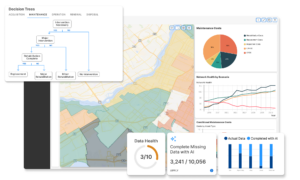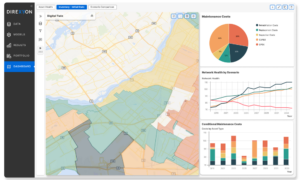The infrastructure deficit: Why it exists and how to address it
The International Institute for Sustainable Development estimates that Canada’s infrastructure deficit ranges from $150 billion to $1 trillion.
Infrastructure is the foundation of modern society. It’s the roads we drive on, the water that runs when we turn the tap. So, how did we get to a place where we have accumulated $1 trillion worth of upkeep and improvements?
What is an infrastructure deficit?
The infrastructure deficit refers to the gap between the current state of infrastructure and the level needed to adequately support public services and economic activities.
It’s an important indicator of assessing asset health and prioritizing investments. A large infrastructure deficit indicates that infrastructure is in poor condition, signaling potential risks and inefficiencies, allowing governments to allocate resources to prevent potential failures or improve service delivery.
Why do we have infrastructure deficits?
Several factors contribute to the infrastructure deficit, with economic challenges being the primary factor.
Infrastructure projects require substantial investment. For instance, building a new highway, expanding a transit system, or replacing 100 km of water infrastructure can cost billions of dollars over several decades. Budget constraints, higher interest rates, and inflation all impact an organization’s ability to fund such projects.
Maintaining and upgrading existing infrastructure can be as disruptive and costly as building new infrastructure. Historically, these projects have often been deferred or neglected in favor of less expensive and less disruptive investments, exacerbating the infrastructure deficit.
Statistics Canada notes that infrastructure spending surged in the 1960s and 70s but was curtailed in the 1980s and 90s due to high budget deficits and a slowdown in population and economic growth. Although infrastructure spending has increased since the 2000s, it has not been sufficient to prevent noticeable degradation of the infrastructure built during the post-war boom, which is now rapidly reaching the end of its useful life.
Decades of underinvestment and deferred maintenance, combined with population growth, urban expansion, and climate change, have put additional strain on this aging, underinvested infrastructure. The infrastructure is now being used beyond its original capacity, leading to more frequent repairs and further inflating the deficit.
How do we address the infrastructure deficit?
In the simplest terms, the best way to address the infrastructure deficit at the local, provincial, and federal levels is to make efficient investments.
Funding sources like federal envelopes for infrastructure development and municipal tax revenues remain insufficient to close the gap. But at least by making efficient investments with the funds available, governments can make strides to reduce the infrastructure deficit by targeting key areas.
An Asset Investment Planning (AIP) solution can play a critical role in addressing the infrastructure deficit by helping governments at all levels make more efficient, data-driven decisions about infrastructure investments.
Here’s how an AIP solution can help address the infrastructure deficit:
Optimizing Resource Allocation
AIP solutions allow governments to prioritize infrastructure projects based on a variety of factors, such as asset condition, risk of failure, and strategic importance. By using advanced analytics and predictive modeling, these solutions ensure that limited funding is directed toward the most critical infrastructure needs, maximizing the impact of every dollar spent.
Scenario Analysis and Long-Term Planning
AIP solutions enable decision-makers to model different investment scenarios and evaluate their long-term outcomes. For example, governments can assess the trade-offs between repairing aging infrastructure versus investing in new projects. This allows them to choose investment strategies that reduce the infrastructure deficit over time while considering future population growth, climate impacts, and evolving service demands.
Risk Management
With integrated risk management features, AIP tools help governments identify and mitigate risks associated with infrastructure failure. This is particularly important for aging assets, where deferring maintenance can lead to more costly emergency repairs or service disruptions. By identifying these risks early, governments can plan proactive investments that prevent infrastructure failures and reduce future costs.
Preventative and Predictive Maintenance
AIP solutions can also assist governments in shifting from reactive to preventative and predictive maintenance strategies. By monitoring asset performance and leveraging data analytics, governments can predict when critical infrastructure components are likely to fail and schedule maintenance before costly breakdowns occur. This proactive approach reduces long-term repair costs, extends asset lifespans, and minimizes disruptions to essential services.
Maximizing Existing Funding
AIP solutions support governments in exploring funding options and making informed decisions on how to allocate federal, provincial, and municipal funds most efficiently. By simulating different funding strategies and investment approaches, municipalities can align their plans with available resources while still addressing critical infrastructure needs.
Data-Driven Decision-Making
AIP platforms provide comprehensive data insights, allowing governments to make decisions based on asset performance, lifecycle costs, and future demand. This data-driven approach helps avoid costly mistakes, reduces inefficiencies, and ensures that infrastructure investments are sustainable in the long run.
With these features, an AIP can provide essential support to address, manage, and reduce the infrastructure deficit efficiently.
Measuring the effectiveness of infrastructure investments
Stable, continuous investments in infrastructure from all three levels of government is the only hope of reducing the deficit that’s built up over decades. But even with a long-term commitment to infrastructure spending, efficient investments are key.
With the support of an AIP solution, all three levels of government can test the long-term impacts of their decisions against asset performance, risk, and financial health to ensure the essential services delivered by critical infrastructure remains viable long-term.
For more information on how Direxyon’s AIP can help your organization make efficient infrastructure investments, contact us today.



